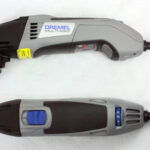Most table saw blades can be changed in the same way. There are safety procedures to follow, though so you can keep your fingers. That’s not a joke. Many woodworkers have been injured and maimed by forgetting that the blade doesn’t know the difference between wood and flesh. Even the new table saws with automatic braking technology that sense when flesh is touching the blade, a serious injury can result.
All table saws come with blade changing instructions in a booklet, but like most booklets they are lost or misplaced over time. You can get a replacement booklet from your table saw’s manufacturer. But you don’t have to wait to get the replacement booklet.
By following the given steps, you can safely change any table saw blade.
Step One
Make sure the table saw is off and unplug it. By unplugging the saw, an accidental bump will not turn it on while your hands are near the blade. This is the most important safety step you will ever follow when working around or near a table saw.
Step Two
Remove the face plate over the saw blade. This will allow you access to the blade nut which holds the blade to the motor’s rotator arm.
Your table saw came with one or two wrenches to change the blade. Get them out now. If you have two wrenches, one goes on the arbor nut behind (near the motor) the blade and the other goes to the front nut of the blade. The arbor wrench holds the blade still while the other wrench is turned. To determine which way to turn your wrench, look at the threads.
If a little WD-40 or other lubricant is used to help loosen the nut, make sure it is completely wiped off before you start the motor again. Some solvents are petroleum based and have volatile fumes (they will spark and burn).
Do not at any time get a hammer to bang on the wrench to turn the nut. This can damage the motor and the arm to the point of needing replacement. It can also knock the arm so far out of alignment that you won’t be able to safely use the saw. Take the time to do it right and safely.
Some woodworkers advocate placing a scrap of wood or block of wood against the teeth of the saw blade to keep it from turning. I can tell you from my own woodworking experience- I pay a lot of money for some of my blades and won’t risk ruining them or bending the teeth by doing this.
If the single wrench makes the blade turn, get a second wrench (make sure that it’s the correct size) and hold the arbor nut while you turn the front nut.
If there is a balancing washer between the nut(s) and the blade, don’t throw them out. They keep the blade from wobbling- something that is far too dangerous to allow any blade to do.
Step Three
Once the blade is removed, inspect the arm for any damage or rust. Are there any signs of burning or sparking in or around the motor? This may be a good time to replace it.
Step Four
Take the new blade and install it using the reverse of the first two steps. Make sure you noted which way the blade rotates in the saw; the blade will have an arrow to indicate which way to mount it.
Tighten the nuts, making sure they are snug. Do not over tighten or strip the threads.
Step Five
Lower the blade and replace the throat plate. Raise the blade until it shows through the slot. Turn the blade by hand to make sure it doesn’t wobble. If it’s running straight, plug the saw back in and turn it on briefly. Check the alignment of the blade and use.
As long as general safety rules are followed, changing a table saw blade is a quick and easy process.


